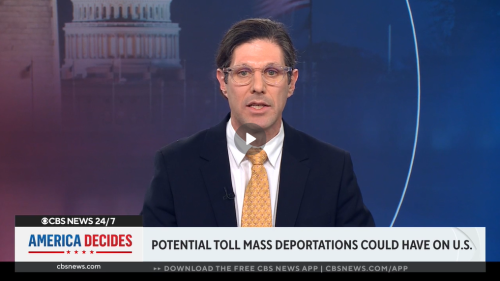Maybe you saw us featured on Last Week Tonight with John Oliver?
The mass deportation of millions of undocumented individuals would be tremendously expensive and would have a catastrophic impact on our economy—one that would be expansive and impact every American.
Read the full report and see below for findings to share with your communities.
Key Findings
- About 11 million undocumented immigrants lived in the United States as of 2022—3.3 percent of the country’s overall population. An additional 2.3 million removable immigrants were released into the United States between January 2023 and April 2024 and would also be targeted in any mass deportation operation.
- A one-time operation to deport these immigrants would cost at least $315 billion, broken down as follows:
- The government would have to spend $89.3 billion to conduct sufficient arrests.The government would have to spend $167.8 billion to detain immigrants en masse.The government would have to spend $34.1 billion on legal processing.The government would have to spend $24.1 billion on removals.
- We estimate the total detention costs for a single mass-deportation operation at $167.8 billion.
- Deporting one million immigrants per year would incur an annual cost of $88 billion, with the majority of that cost going towards building detention camps. It would take over ten years, and the building of hundreds to thousands of new detention facilities, to arrest, detain, process, and remove all 13.3 million targeted immigrants—even assuming that 20 percent of that population would depart voluntarily during any multi-year mass deportation effort. The total cost over 10.6 years (assuming an annual inflation rate of 2.5 percent) would be $967.9 billion. The annual costs would break down as follows:
- The government would have to spend an average of $7 billion per year to conduct one million arrests annually.
- The government would have to spend an average of $66 billion per year to detain one million immigrants annually, or surveil them on alternatives to detention programs while detention capacity ramps up to one million.
- The government would have to spend an average of $12.6 billion per year to carry out legal processing for an average of one million immigrants annually.
- The government would have to spend an average of $2.1 billion per year to remove one million immigrants annually.
- To carry out over 13 million arrests in a short period of time would require somewhere between 220,000 and 409,000 new government employees and law enforcement officers, which would be nearly impossible given current hiring challenges across law enforcement agencies. Even carrying out one million at-large arrests per year would require ICE to hire over 30,000 new law enforcement agents and staff, instantly making it the largest law enforcement agency in the federal government. Carrying out one million at-large arrests per year would require ICE to hire over 30,000 new law enforcement agents and staff, instantly making it the largest law enforcement agency in the federal government.
- Mass deportation would exacerbate the U.S. labor shortage. In 2022, nearly 90 percent of undocumented immigrants were of working age, compared to 61.3 percent of the U.S.-born population aged between 16 and 64, making undocumented immigrants more likely to actively participate in the labor force. Losing these working-age undocumented immigrants would worsen the severe workforce challenges that many industries have already been struggling with in the past few years.
- Mass deportation would hurt several key U.S. industries that rely heavily on undocumented workers. The construction and agriculture industries would lose at least one in eight workers, while in hospitality, about one in 14 workers would be deported due to their undocumented status. Among those industries, certain trades would be hit even harder. Mass deportation would remove more than 30 percent of the workers in major construction trades, such as plasterers, roofers, and painters; nearly 28 percent of graders and sorters of agriculture products; and a fourth of all housekeeping cleaners. Mass deportation would hurt several key U.S. industries. The construction and agriculture industries would lose at least one in eight workers, while in hospitality, about one in 14 workers would be deported due to their undocumented status.
- Among the deported would be 1 million undocumented immigrant entrepreneurs, who generated $27.1 billion in total business income in 2022. Losing the 157,800 undocumented immigrant entrepreneurs in neighborhood businesses would lead to disruptions to services that have become an integral part of community life and provide local jobs for Americans. Undocumented immigrant entrepreneurs generated $27.1 billion in total business income in 2022
- The U.S. would lose out on key contributions undocumented households make to social safety net programs annually, including $22.6 billion to Social Security and $5.7 billion to Medicare. As the U.S. population ages, the loss of these payments would make it increasingly challenging to keep social safety net programs solvent.
- Mass deportation would deprive federal, state, and local governments of billions in local tax contributions from undocumented households. In 2022 alone, undocumented immigrant households paid $46.8 billion in federal taxes and $29.3 billion in state and local taxes. After taxes, they were left with $256.8 billion in spending power, money that could be spent in local communities.
- Deporting undocumented immigrants would separate 4 million mixed-status families, affecting 8.5 million U.S. citizens with undocumented family members (5.1 million of whom are U.S. citizen children). It would slash the income of their households by an average of 62.7 percent ($51,200 per year). Deporting undocumented immigrants would separate 4 million mixed-status families, affecting 8.5 million U.S. citizens with undocumented family members
- Overall, mass deportation would lead to a loss of 4.2 percent to 6.8 percent of annual U.S. GDP, or $1.1 trillion to $1.7 trillion in 2022 dollars. In comparison, the U.S. GDP shrunk by 4.3 percent during the Great Recession between 2007 and 2009.
- The negative impact would be the most significant in California, Texas, and Florida, the three states that were home to 47.2 percent of the country’s undocumented immigrants in 2022 and where one in every 20 residents would be deported.




